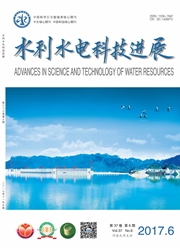

 中文摘要:
中文摘要:
以湿周与流量关系为基础,建立了基于多目标评价方法的河道最小生态需水量估算模型,以湿周最大和河道流量最小作为栖息地保护和水资源开发利用的目标,采用理想点法求解,以增江下游麒麟咀站为例计算河道最小生态需水量,并将该模型的计算结果与斜率法和曲率法的计算结果进行了比较分析。结果表明:增江下游河道最小生态需水量阈值范围为20.8~26.3 m3/s,相应的平均流速范围为0.42~0.44 m/s;模型计算结果比传统的湿周法适用性更强,且能较好体现生态用水和经济用水的均衡发展。
 英文摘要:
英文摘要:
A multi-objective evaluation model is established to estimate the minimum environmental flows(MEF) based on the relationship between wetted perimeter and discharge.Regarding the maximum wetted perimeter and the minimum river discharge as objectives for habitat protection and water resources utilization respectively,the model is solved by means of the ideal point method,and MEF in the downstream of Zengjiang River is calculated by the multi-objective evaluation model and compared with that calculated by the slope method and the curvature method.The results show that the MEF threshold at Qilinzui station in the downstream of Zengjiang River ranges from 20.8 to 26.3 m3/s,and the corresponding average velocity is from 0.42 to 0.44 m/s.The results calculated by the multi-objective evaluation model have stronger applicability for determination of MEF than those by the traditional wetted perimeter method,and they can better reflect the balanced development between the ecological and economic water uses.
 同期刊论文项目
同期刊论文项目
 同项目期刊论文
同项目期刊论文
 Spatio-temporal patterns of hydrological processes and their responses to human activities in the Po
Spatio-temporal patterns of hydrological processes and their responses to human activities in the Po Impacts of climate change and human activities on surface runoff in the Dongjiang River basin of Chi
Impacts of climate change and human activities on surface runoff in the Dongjiang River basin of Chi Changing properties of hydrological extremes in south China: natural variations or human influences?
Changing properties of hydrological extremes in south China: natural variations or human influences? Multiscale streamflow variations of the Pearl River basin and possible implications for the water De
Multiscale streamflow variations of the Pearl River basin and possible implications for the water De Precipitation variability (1956~2002) in the Dongjiang River (Zhujiang River basin, China) and assoc
Precipitation variability (1956~2002) in the Dongjiang River (Zhujiang River basin, China) and assoc Statistical behaviours of precipitation regimes in China and their links with atmospheric circulatio
Statistical behaviours of precipitation regimes in China and their links with atmospheric circulatio Estimation of evapotranspiration using remotely sensed land surface temperature and the revised thre
Estimation of evapotranspiration using remotely sensed land surface temperature and the revised thre The Influence of dam and lakes on the Yangtze River streamflow: Long-range correlation and complexit
The Influence of dam and lakes on the Yangtze River streamflow: Long-range correlation and complexit 期刊信息
期刊信息
